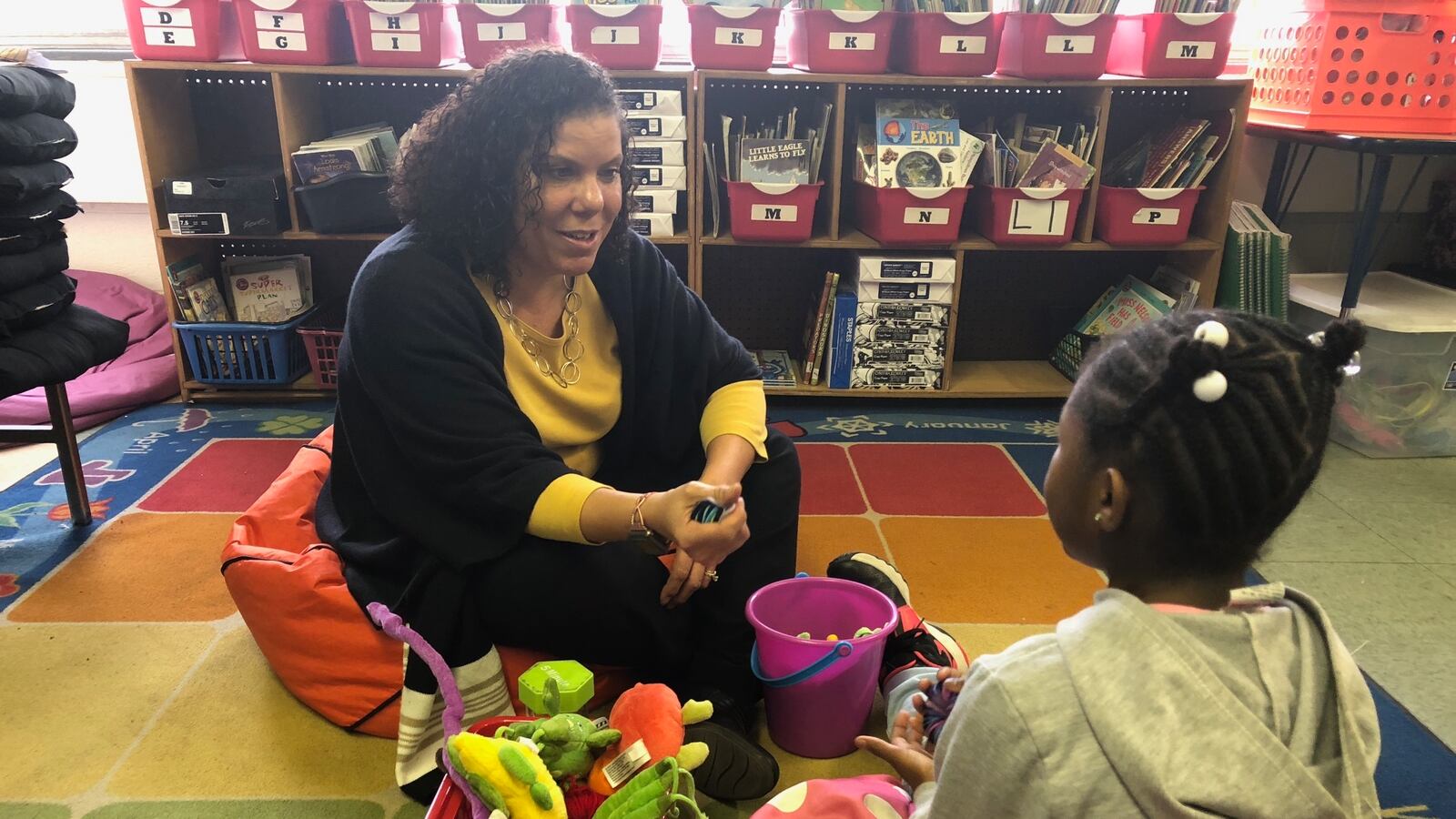This article was originally published in The Notebook. In August 2020, The Notebook became Chalkbeat Philadelphia.
Koosh balls, silly putty, ball-bearings, small stuffed toys. These are some of the tools used to defuse emotional outbursts or erratic behavior at Samuel Powel Elementary, K-4 school in West Philadelphia.
They’re referred to as fidgets, amd they’re part of a list of strategies designed to address possible trauma by engaging students’ brain functions.
“It’s very relaxing,” said Sinaya McCants, a second-grade student at Powel. “It calms me down and helps me control my anger so I don’t hit anybody or hurt anybody.” She never actually hit or hurt anyone before, she said, but she uses the strategies “just in case.”
Pamela Turner-Bunyon, the school’s counselor, said Sinaya used to be sent to her office multiple times a day due to emotional outbursts that were difficult to de-escalate. But now, thanks to tools such as fidgets, days go by before Sinaya winds up in her office. And usually it’s for “treats” like candy or hugs.
“It’s not because I don’t want to see her, but because she’s using the strategies,” Turner-Bunyon said.
Such strategies come from Lakeside’s Neurologic Initiative, where teachers receive training on trauma-informed education. Powel, one of the seven schools to receive a Promise Neighborhood Grant, is among a handful of schools in the District to receive training through the initiative.
And now in an effort to expand their reach to more schools, Lakeside is offering training through an online video course.
“We only have so many hours in the day, schools have only so many professional development days, which is really where our program is laser focused on,” said Josh MacNeill, director of the Neurologic Initiative, who does the bulk of the teacher training. “So trying to get that information to them as quickly and easily as possible is the goal here.”
Lakeside is offering concepts designed to help calm students in various situations and prepare their brains for learning through two online video courses. The first is a four-hour intensive to introduce educators to a trauma-informed approach to teaching, where the specifics of brain function are explained along with practical methods of application in the classroom. The other is an eight-hour course that builds on the concepts from the intensive.
The courses offer 10-25 minute tutorials that first teach the science and impact of trauma on the brain. Then they explore strategies such as brain breaks, exercises that calm students and prepare their minds for learning; regulation areas, a space where students can calm themselves down while still participating in class–peace corners, for example; and fidgets, handheld toys and trinkets that allow students to… fidget.
The courses cost a total of $400, making it a cost-effective alternative for schools on a budget.
“If I could clone us and go out and do tons of training and make it extremely inexpensive, I’d do that in a second,” said MacNeill. “But that’s not practical, so this is the next best thing.”
The courses are still in the early stages of their release so it’s too early for feedback, but the training itself is proving to have a significant impact for teachers who’ve bought in.
Powel teacher Tara Shaw said she has seen significant changes since implementing Neurologic’s strategies in her classroom. Last year she’d have to send students to Bunyon’s office almost daily, she said, but since taking the training this year, she has yet to do so.
The exercises allow students to develop a sense of emotional intelligence they can tap into when they feel themselves getting worked up, so it is typical for students to go to the peace corner with a fidget on their own volition.
In Shaw’s room, the peace corner has about three feet of wall space dedicated to signs that help students identify how they feel, a wobble chair, and a basket of fidgets. While wobbling and fidgeting the students let off steam and while still participating in class.
“It made me be more reflective about my interaction with students, so that I’m calm with the students and they’re calm, so they can think about what they need to do,” Shaw said.
Turner-Bunyon said this is the case in other classrooms where teachers have adopted the new approach. She said of those teachers who use Neurologic’s strategies, she hasn’t had many of their students sent to her office.
Despite such results, she said the biggest challenge is getting other teachers to change their ways. One of the reasons, Turner-Bunyon said, is since the program is very trauma-centered, it requires educators to look within themselves in order to empathize with their students, which may prove difficult for some.
“You’re processing your own pain to be able to be present with children,” Turner-Bunyon said. “It’s about the adults being more intentional. So the roadblocks are real because we’re all humans. We’re all involved in this human experience and we all have to be willing to make those changes to then go forward.”
MacNeill said teacher pushback is the biggest hurdle the initiative faces, especially from those who’ve been teaching for a long time. It isn’t an easy process to change the paradigm of the classroom, but he assures the mission of the Neurologic Initiative is to provide schools with the tools they need to stay the course.
“Students are changing, the culture is constantly changing. It’s a long-term process to become that,” he said. “We kind of condensed ourselves for teachers, for professionals to get that core information that foundational information that needs to be there…and just create a hub of resources for people.”
For more information about the Neurologic Initiative visit www. lakesidelink.com.


